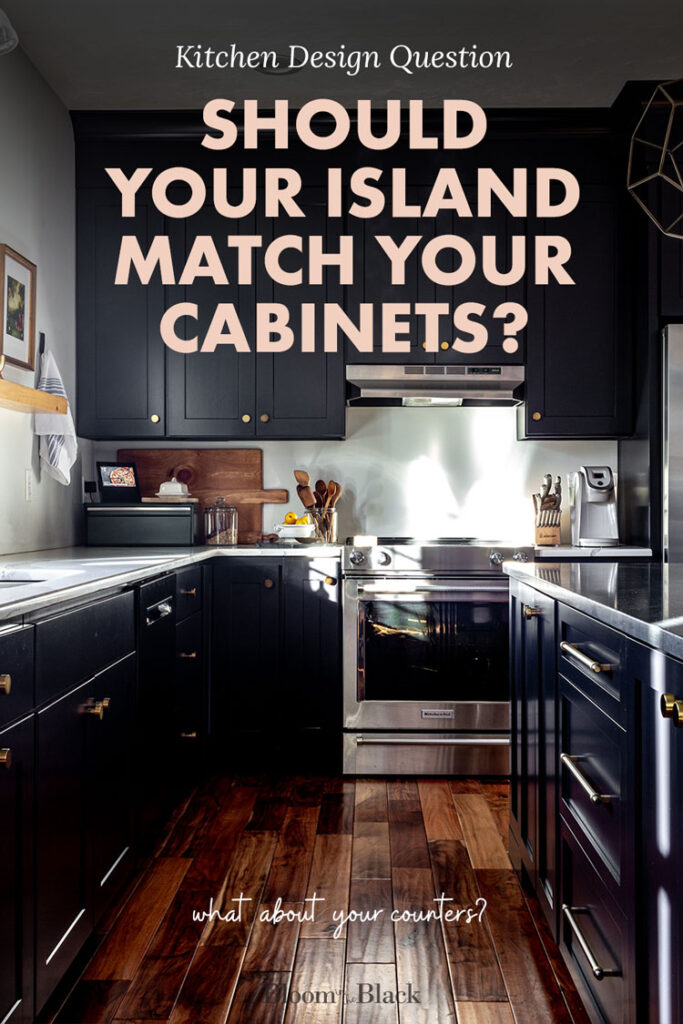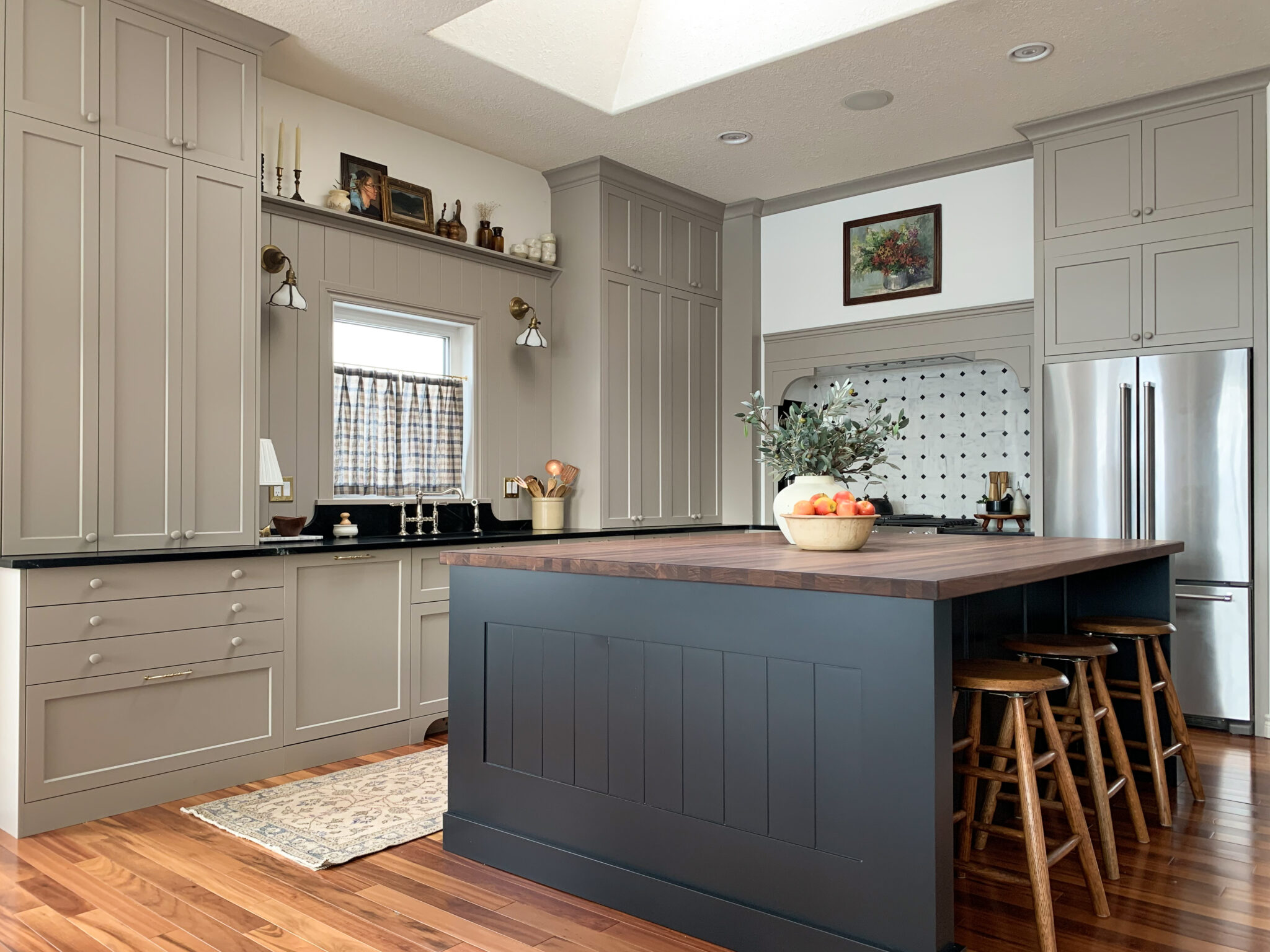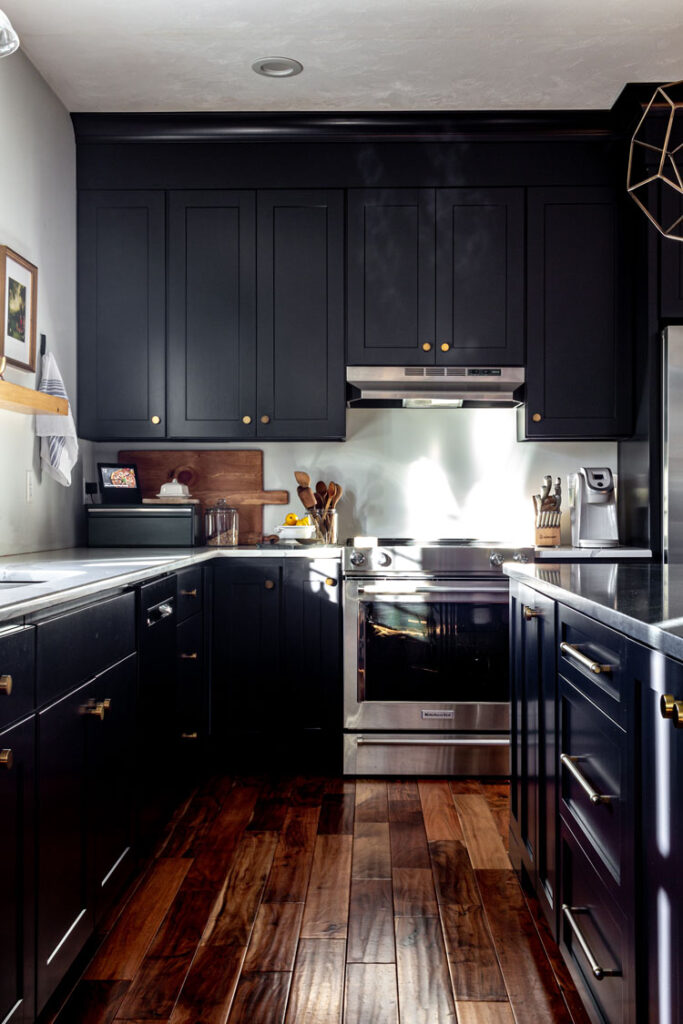Should Your Kitchen Island Match Your Cabinets? Your Color Questions Answered
If you have a kitchen update in your future, you might be unsure about how to approach your kitchen island design. Should it match your cabinets? Contrast? What are the guidelines around mixing and matching?
A kitchen island that doesn’t match your cabinets and/or counters is the best choice for a high-end look. Whether your kitchen island should match your cabinets is a matter of preference. Still, when it matches your cabinets and countertops exactly, the result can come off as builder-basic and lacking personality. Your best bet is to contrast either the color of the cabinets, the countertop material, or even both.
In this post, we’re going to explore the pros and cons of a matching kitchen island vs. a contrasting kitchen island, guidelines for getting it right, and how to choose what’s best for you.
Pin for later!

This post contains some affiliate links for your convenience. Click here to read my full disclosure policy. Thanks for supporting Bloom in the Black!
Does Your Island Have to Match Your Cabinets and Countertops?
In short, no. And it really shouldn’t. Modern kitchens have far more personality and variety than they did even a few years ago. Anything that can be perceived as cookie-cutter can cheapen the look of an otherwise very beautiful kitchen. This includes a kitchen island that perfectly matches your cabinets and countertops.
Think of how we now approach furniture. Do you buy the entire matching bedroom set? Of course not! You mix and match to create a considered personal look for your home.
The same goes for a kitchen. Just take a look at how impactful Kate’s kitchen island is:

The Case for Matching
OK, OK, so what if you just really love the look of a matching island and contrast just doesn’t do it for you?
You should, of course, do what you love in your own home.
Lots of people opt for a matching kitchen island and cabinets when it comes to their kitchen design. The clearest advantage of matching is that it easily achieves a cohesive look. If you prefer a more traditional look and feel uncertain about combining different colors, styles, and materials, matching your kitchen island to your cabinets might be the way to go.
The Case for Contrast
I’ve already made it clear which camp I fall into, but let’s explore some reasons why not matching your island to the surrounding cabinets and perimeter countertop is a good choice.
The main benefit of a contrasting kitchen island is the opportunity to add major visual impact to your kitchen. Mixing and matching different colors and materials will create a far more personalized look that reflects your unique style and aesthetic.
And frankly, a customized kitchen island that doesn’t match your cabinets just plain looks more expensive — even if it didn’t cost an extra dime. This is because it shows more thought and consideration went into the design process, which creates the illusion of having spent more money.
How To Mix and Match Kitchen Island Finishes
If you decide to do a contrasting island (yay!), there are three ways to go about it:
- Match the cabinets and contrast the counters
This is the approach I took in my kitchen. Matching the kitchen island color to your cabinets while opting for a contrasting countertop material is a simple, low-risk way to mix and match your kitchen finishes. Be sure to use a distinctly different counter on your island than on the perimeter — if the finishes are too close, it can look like a mistake. Successful combinations include:- Black granite on the perimeter with white marble or quartzite on the island
- Soapstone on the perimeter with butcher block on the island
- White quartz on the perimeter with a statement stone on the island
- Contrast the cabinets and match the counters
This is basically the inverse of the first option, but you have a little more flexibility with the cabinet color. Where with counters, you want a distinct contrast, a more subtle contrast in cabinets colors can look very intentional. On the flip side, a bold island cabinet color can create excitement when paired with a quiet color. Here are some ideas:- White perimeter cabinets with taupe island cabinets
- Navy perimeter cabinets with richly stained island cabinets
- Cream perimeter cabinets with olive green island cabinets
- Contrast both the cabinets and the counters
This option is pro-level. It can be tricky to balance all elements, but the result is incredible if you do. Take a look at Erin’s kitchen below to see this level of contrast executed flawlessly:

Should Your Kitchen Island Be Lighter or Darker Than Your Cabinets?
Traditionally a kitchen island is darker or bolder than your cabinets, but that’s not set in stone. The deciding factor should be your personal preferences and design aesthetic.
Here are a few things to consider when deciding on the color or finish of your kitchen island:
- Functionality: A dark or mid-tone kitchen island is going to show fewer scuffs and grime, which is an essential consideration if you plan to have seating at the island. A contrasting backer in a deeper color or material can be used if you want a lighter island with seating. If it’s a storage island, anything goes.
- Color scheme: Think about the colors used in your kitchen when choosing the color or finish of your kitchen island. For example, if your kitchen has a neutral color scheme, a kitchen island in a contrasting color or finish can add some visual wow factor. If your kitchen already has a bold color scheme, choose a kitchen island in the same color or a neutral to create a pulled-together look.
- Personal preference: Ultimately, choosing a lighter or darker kitchen island should be based on your personal design preferences. In other words, you do you!
- Budget: Some countertop materials are very expensive! A great way to get the look you love within your budget is to select a less expensive counter for the majority of your kitchen, and splurge on a statement stone for your island. Depending on your island’s size, it may be more affordable than you think.
Be sure to check out my article on the best size for your kitchen island if you’re just starting a kitchen renovation.
Can You Mix Countertop Materials in Your Kitchen?
Yes, you can absolutely mix different countertop materials in your kitchen. This is actually a wonderful way to create a high-end, custom look.
You need to keep a few things in mind when mixing countertop materials in your kitchen. Choosing materials in complementary styles, colors, and overall aesthetics is really important.
For example, if you have wooden cabinets with marble counters on the perimeter, you could choose a butcher block counter for your island to echo the wood of the perimeter cabinets.
More importantly, you need to consider the durability of the materials you choose for each work zone. Materials like marble and granite are more porous and prone to staining so they may be more suited to the areas of the kitchen you on;t be doing a lot of meal prep or dining. Quartz and solid surface materials are more resistant to stains and scratches, so these would be a good choice for areas of the kitchen that get heavier use, like a kitchen island. All that said, if you’re willing to accept the character that comes with time on these less durable materials, anything goes!
For example, I personally adore soapstone and did not hesitate to use it on my island despite the fact that it’s easily scratched. I love the patina that comes with age. But I opted for a heavily veined white and gray quartz on the perimeter to add lift and contrast to the colors in the kitchen.

In short, mixing countertop materials is an effective way to personalize the look of your kitchen. Just be sure to think through the materials you choose and how they’ll work together in terms of both aesthetics and functionality.
What’s the Best Color for Your Kitchen Island
The best color for a kitchen island is the color YOU like best. It all depends on your personal style and the overall design aesthetic you’re trying to create in your kitchen. That said, there are a few guidelines to keep in mind when narrowing down your options:
- Functionality: What does functionality have to do with paint color? Basically, hiding dirt and scuffs. Many (if not most) kitchen islands have seating and with seating comes dirty feet and shoes kicking the back of the island. Mid-tone to darker colors tend to hide this wear and tear a bit better than lighter colors. Lighter colors can work, just be prepared to have to clean and do touchups more often.
- Color scheme: Think about the overall color scheme of your kitchen when choosing the color for your kitchen island. If your kitchen has a neutral color scheme, you could do a kitchen island in a bold color to add some visual interest. If your kitchen has a bold color scheme, you might choose a kitchen island in a neutral color to balance out the space.
- Personal preference: Ultimately, the best color for your kitchen island is one that you love. Take the time to consider your personal design preferences and choose a color that aligns with your vision for your kitchen.

BTW: Did you know your kitchen island seating can face more than one way? I wrote this helpful article covering which way your island seating should face.
Conclusion
Ultimately, the decision of whether your kitchen island should match your cabinets is totally up to you. While mixing the colors or materials of your kitchen island and cabinets is generally considered to be a more modern choice, a well-considered matching island might be what’s best for you!
